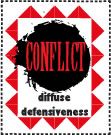Diffusing Defensiveness
Managing Responses
Building goodwill by investing in rapport and trust and by showing interest, genuineness, reliability and reasonableness is very important in cultivating relationships. Be aware of your own emotions: manage them so they don't interfere with your own judgement or behavior.
Obvious Signs of Defensiveness
Sometimes displays of defensiveness are obvious and sometimes displays of defensiveness are subtle. Here are some signs that will help you to spot defensiveness:
- Someone looks angry and starts to talk fast
- Someone shows an obvious form of agitation, for example tapping a foot
- Someone might too readily agree with what is being said
Guidelines For Responding to Defensiveness
Demeanor
- Allow it and model how you want them to act: calm, reasonable and under control
- Speak normally, without raising your voice
- Minimize unnecessary conversation and movement
- Maintain a calm, interested tone of voice and an empathic interest in the person's concerns, rather than focusing on what you want
Verbal Interventions
- Restate their position
- Acknowledge their feelings
- If you're not sure how to respond - don't. Take a momentary break or pause to absorb the meaning of what is happening and what is being said
- Seek the person's point of view - how does the person see things?
- Seek the person's view of what would help the situation
- Discuss all possible parts of their suggestions
- if no parts of the suggestions are possible, explain why and offer alternatives
This information was paraphrased from the Conflict Resolution in Teacher Education Instructor Guide, Day 2,
Guidelines for De-escalating Crisis, edited by Tricia S. Jones, PhD
Licensed under the Creative Commons Attribution-NonCommercial-ShareAlike 2.5 License
Brought to you by CReducation.org.